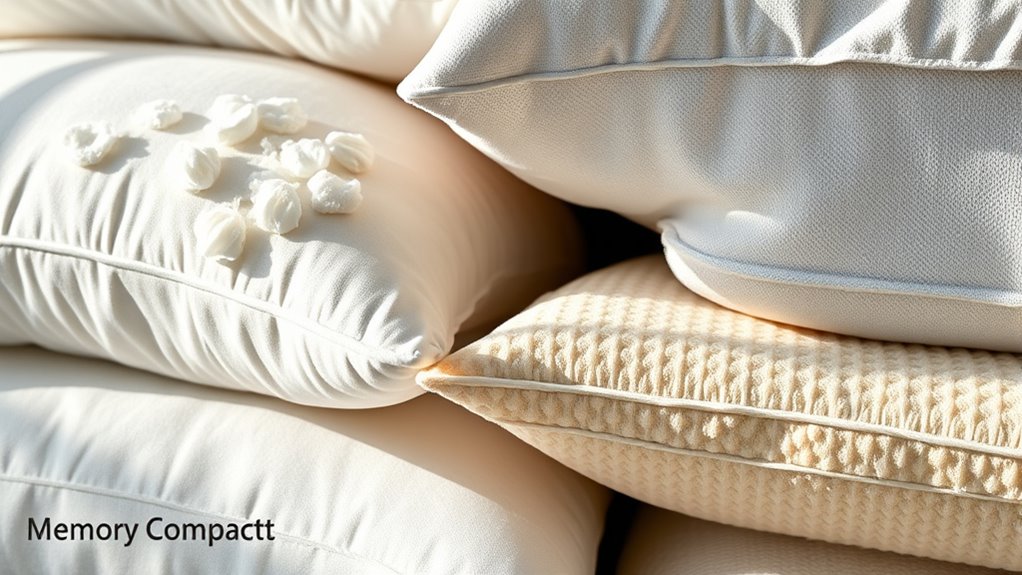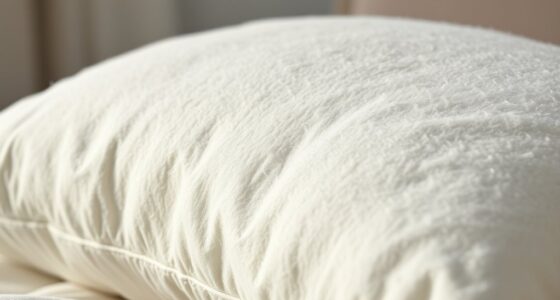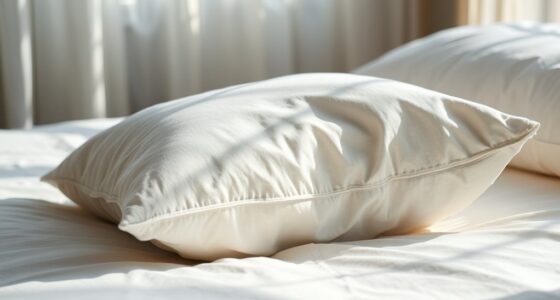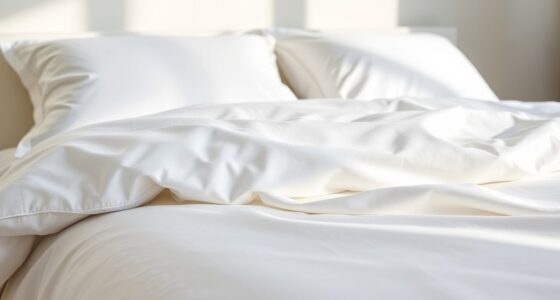Understanding pillow fill power and density helps you choose the right support, comfort, and durability for a better night’s sleep. Fill power measures how lofty and resilient the pillow’s filling is, with higher numbers offering more loft and support. Density indicates how tightly the fill is packed, affecting firmness and breathability. Combining the right fill power and density guarantees your pillow stays supportive and comfortable over time. Continue exploring to discover tips for selecting the perfect pillow for you.
Key Takeaways
- Fill power measures loft and resilience; higher fill power means a more supportive, longer-lasting pillow.
- Density indicates how tightly the fill material is packed, affecting firmness, breathability, and durability.
- A proper balance of fill power and density ensures consistent support and reduces lumps over time.
- Hypoallergenic fills with optimal fill power and density help resist dust mites and mold, improving allergy management.
- Innovations like AI-adaptive materials enhance comfort, shape retention, and pillow lifespan through better fill choices.
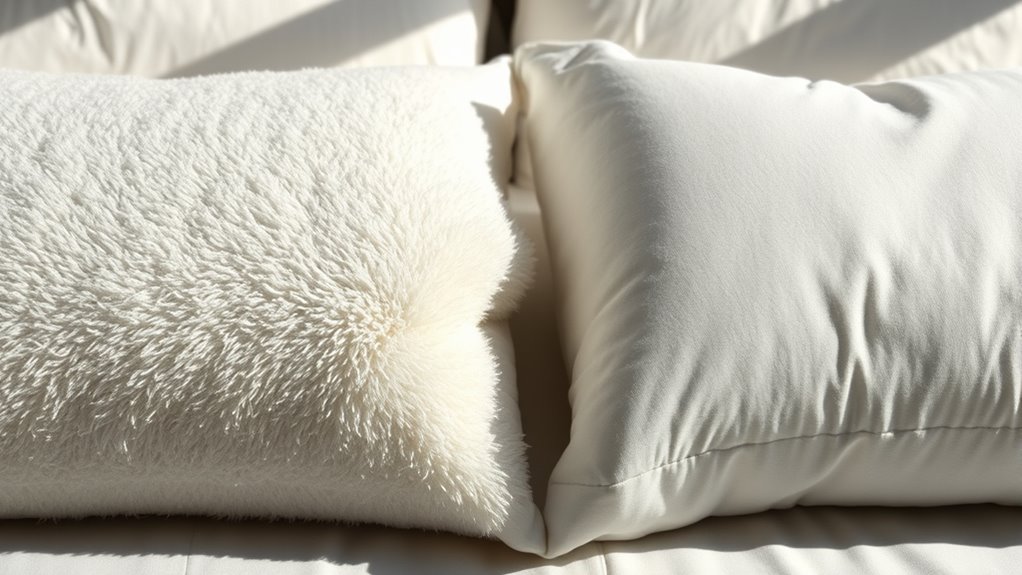
Have you ever wondered what makes some pillows feel softer and more supportive than others? The secret often lies in the pillow’s fill power and density, two key factors that influence your sleep experience. When you choose a pillow, understanding these elements can help you find one that not only enhances your sleep quality but also addresses allergy considerations. Higher fill power generally means a pillow is more lofty and resilient, providing better support without feeling flat. This loftiness can help keep your head and neck properly aligned, reducing discomfort and promoting deeper, more restful sleep. Conversely, lower fill power pillows tend to be denser but less lofty, which might feel crumblier or less supportive over time. Knowing this helps you pick a pillow that suits your preferred firmness and support level, making a noticeable difference in your sleep quality night after night.
Additionally, advancements in AI-powered materials are leading to innovative pillow designs that adapt to your sleep position and temperature, offering even more personalized comfort. Density is equally important. It refers to how tightly the fill material is packed inside the pillow. A dense pillow can feel firmer and more durable, offering consistent support over years of use. However, it can also be heavier and less breathable, which might be uncomfortable if you tend to sleep hot. On the other hand, less dense pillows are often lighter and more breathable, helping regulate temperature and prevent overheating during the night. When considering allergy considerations, density plays an essential role. Many allergy sufferers opt for hypoallergenic fills, such as memory foam or specially treated down alternatives, which resist dust mites and mold better than traditional feather or down fillings. These hypoallergenic options often have a specific fill power and density that make them both supportive and resistant to allergens.
It’s also worth noting that the relationship between fill power and density impacts how well your pillow maintains its shape and support over time. A high fill power with appropriate density will retain its loft longer, meaning fewer lumps and a consistently comfortable sleep surface. This durability is especially important if you have allergies because fewer dust mites and mold tend to accumulate on high-quality, supportive pillows. Additionally, selecting a pillow with the right fill power and density can improve sleep quality by reducing neck and shoulder pain and minimizing tossing and turning. Ultimately, understanding how fill power and density work helps you choose a pillow that aligns with your support needs and allergy considerations, leading to a more restful and healthier sleep experience.
Frequently Asked Questions
How Does Fill Power Affect Pillow Lifespan?
Fill power directly impacts your pillow’s lifespan by influencing its durability and how well it resists fill compression. Higher fill power pillows maintain their loft longer, preventing them from flattening quickly, which extends pillow durability. Lower fill power pillows tend to lose their shape faster, leading to more frequent replacements. So, choosing a pillow with appropriate fill power helps you enjoy better support and longer-lasting comfort.
Is Higher Fill Density Always Better for Comfort?
Higher fill density isn’t always better for comfort. It can make your pillow firmer, which might suit some sleep preferences, but it could also trap heat, affecting your sleep temperature. If you prefer a softer pillow or tend to sleep hot, a lower fill density may be more comfortable. Consider your preferred pillow firmness and how it impacts your sleep temperature to find the right balance for you.
Can Fill Power Influence Pillow Allergy Risks?
Did you know that pillows with higher fill power often have better hypoallergenic properties? Fill power influences dust mite resistance because higher-quality fills tend to be less hospitable to allergens. If you’re allergy-prone, choosing a pillow with high fill power can reduce allergy risks by minimizing dust mites and other allergens. So, yes, fill power can markedly impact your pillow’s allergy safety, helping you sleep more comfortably and healthier.
How Do Fill Power and Density Impact Pillow Weight?
Fill power and density directly influence your pillow’s weight; higher fill power signifies lighter, fluffier pillows, while increased density makes pillows heavier and firmer. This impacts your pillow hygiene and sleep quality, as a heavier pillow may trap more allergens and be harder to wash thoroughly. Choosing the right fill power and density ensures better pillow hygiene, helping you sleep comfortably and wake up refreshed.
Are There Differences in Fill Power for Different Pillow Types?
Ever wonder if different pillow types have varying fill powers? Think of your pillow like a story—its material and filling techniques shape its character. Yes, they do! Down pillows often boast higher fill power, offering fluffiness and loft, while memory foam pillows have lower fill power but provide firm support. Your choice of pillow material and filling techniques directly influence the fill power, making each pillow unique in comfort and performance.
Conclusion
By understanding fill power and density, you can choose a pillow that offers both comfort and durability. While some might think higher fill power means only luxury, it actually provides better support and longevity, making your investment worthwhile. Don’t overlook these details—your sleep quality depends on them. With this knowledge, you’ll confidently select a pillow that enhances restful nights and supports your well-being for years to come.
